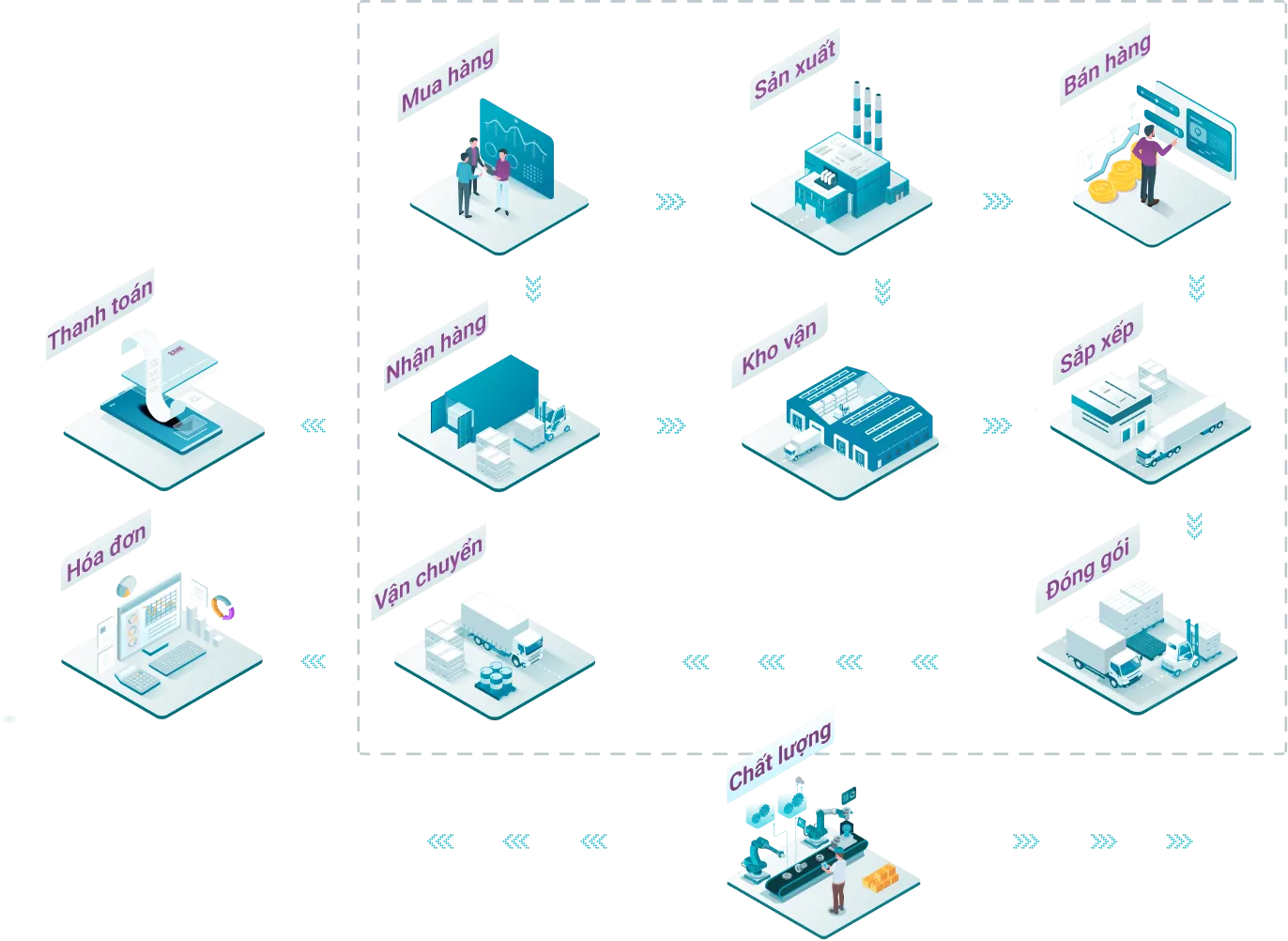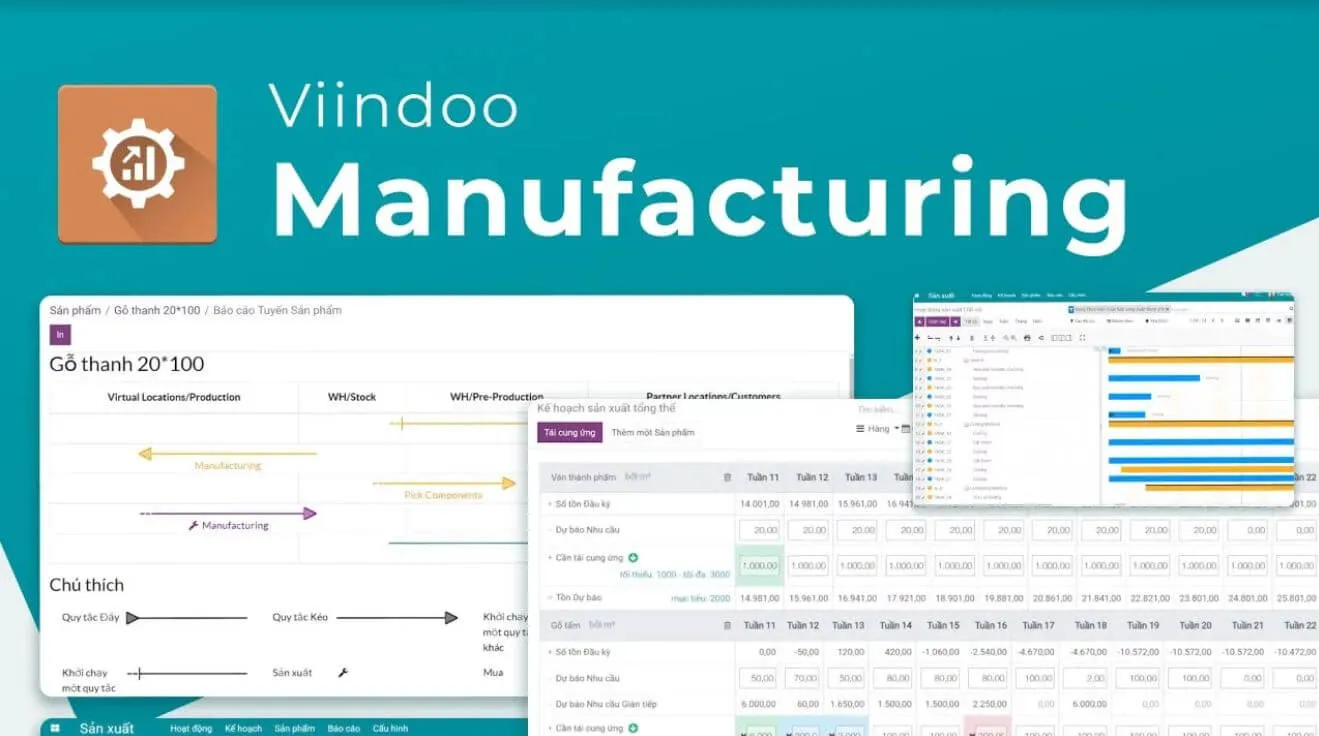Production planning plays a critical role in optimizing production processes, meeting customer demand, and enhancing the productivity and efficiency of the enterprise.
With the advancement of technology, businesses have begun to adopt comprehensive software solutions known as Enterprise Resource Planning (ERP) to optimize production planning processes. In this article, we will explore the benefits that ERP brings to production planning, from its ability to integrate data to addressing specific challenges within the planning process. This helps enhance the productivity and efficiency of the production process, while also meeting the increasingly diverse and changing demands of the market.

The role of production planning

The role of production planning in enterprises is crucial in various aspects, including:
- Optimizing Resources: Production helps planning enterprises optimize the utilization of resources such as labor, materials, and equipment. By planning efficiently, businesses ensure that all resources are used most effectively, enhancing productivity and minimizing waste.
- Meeting Customer Demand: Production planning is designed to efficiently meet customer demand. By predicting and adjusting production to reflect specific market requirements, businesses ensure they provide suitable products and services at the right time.
- Enhancing Productivity and Efficiency: Accurate and flexible production planning enhances the productivity and efficiency of the production process. By allocating resources scientifically and carefully, businesses can produce more within the same timeframe and at lower costs.
- Minimizing Waiting Times: Production planning can help minimize waiting times between production stages, optimizing the production process. This can enhance flexibility and enable rapid adaptation to market demand fluctuations.
- Risk Management: Production planning also helps manage and minimize risks in the production process. By predicting and addressing potential issues before they occur, businesses can minimize the risk of production stoppages and losses.
Using ERP in production planning
The main tasks when using ERP in production planning include data integration and management, demand forecasting, capacity planning, material requirements planning, and output planning. production planning as well as performance monitoring and analysis. ERP systems streamline these tasks, allowing business leaders to make informed decisions, optimize resources, and improve overall operational efficiency in the production planning process.
Data integration and management
One of the main tasks of ERP in production planning is to integrate and manage data from different departments and processes within the organization.
This includes data related to sales forecasts, inventory levels, production capacity and available resources. ERP systems consolidate this information into a centralized database, providing planners with real-time access to accurate data for decision making.

Demand Forecasting
ERP systems support demand forecasting by analyzing historical sales data, market trends, and customer orders. Based on this analysis, the system makes a forecast of future demand, which serves as a basis for production planning.
Accurate demand forecasts enable planners to optimize production schedules and allocate resources efficiently to meet customer demand while minimizing inventory costs.

Capacity Planning
ERP supports capacity planning by assessing production capacity, machine availability, and workforce.
Planners use ERP tools to identify production bottlenecks and optimize production schedules to maximize output and minimize idle time. Capacity planning ensures that production schedules are feasible and appropriate to the organization's resources and capabilities.
Material requirements planning
ERP systems automate the material requirements planning process by calculating the quantity and timing of materials needed for production based on forecasts and demand schedules.
ERP functionality helps optimize inventory levels, reduce overstocking, and minimize excess inventory. Planners can create purchase orders and production orders directly from the ERP system to purchase materials and schedule production accordingly.

Production planning
ERP supports production planning by creating detailed production schedules based on demand forecasts, available resources, and production constraints. Planners can use ERP tools to sequence production, allocate resources, and balance workload on the production line. Real-time visibility into production schedules allows planners to track progress, identify potential delays, and make adjustments as needed to ensure on-time delivery.
Performance monitoring and analysis
ERP systems provide performance monitoring and analysis tools that allow planners to track key performance indicators (KPIs) such as production efficiency, on-time delivery and resource use.
By analyzing production data, planners can identify improvement opportunities, take corrective actions, and continuously optimize the production process to improve overall efficiency and effectiveness. . .

Production Planning according to MTO, MTS, MPS with Viindoo
Viindoo uses production planning methods that suit the diverse and popular production needs of businesses. These include Make to Order (MTO), Make to Stock (MTS), Master Production Planning (MPS). This guide explores how each method optimizes resource usage and improves efficiency within our platform.
Planning production according to Make-to-Order (MTO)

Planning production according to Make-to-Order (MTO) demands a flexible and optimized process to meet specific customer requirements every time an order is received. Here are the basic steps for planning production according to MTO:
- Receive Order: Receive the order from the customer and identify specific requirements for the product, including quantity and delivery time.
- Determine Materials and Resources Needed: Identify the materials and resources required to produce the product as per the order's requirements. This includes determining raw materials, finished goods, labor, and necessary production equipment.
- Create Material List and Resource Planning: Based on the order requirements, create a material list and plan the utilization of resources such as labor and production equipment. Ensure all resources are utilized efficiently and are sufficient to complete the order as required.
- Define Production Process: Define the specific steps in the production process for the product, from machining to assembly to quality inspection. Determine the sequence and time required for each step in the production process.
- Detailed Production Planning: Based on the material list, create detailed production planning to determine the start and finish times for each production task. Ensure that the production plan accurately reflects the time needed to complete the order.
This planning method is suitable for businesses that produce according to orders such as processing companies, export manufacturing enterprises...
>>> See more: Make to Orders (MTO) replenishment in Viindoo
Planning production according to Make-to-Stock (MTS)
Planning production according to Make-to-Stock (MTS) involves forecasting demand and producing goods based on anticipated sales rather than specific customer orders. In MTS, products are manufactured and stocked in inventory before customer orders are received. This approach allows businesses to fulfill orders quickly and efficiently, as products are readily available for immediate delivery. It also helps minimize lead times and allows for economies of scale in production. However, effective MTS production requires accurate planning demand forecasting, inventory management, and coordination across various departments to ensure optimal stock levels and prevent overstock or stockouts.

Planning production according to Make-to-Stock (MTS) involves forecasting demand and manufacturing products based on anticipated sales rather than specific customer orders. The process typically follows these steps:
- Demand Forecasting: Analyze historical sales data, market trends, and other relevant factors to forecast future demand for the product.
- Inventory Management: Determine optimal inventory levels based on demand forecasts, lead times, and storage constraints. This includes setting safety stock levels to buffer against demand volatility and prevent stockouts.
- Production Scheduling: Develop a production schedule based on the forecasted demand and inventory levels. Determine the quantity of products to be manufactured within a specified timeframe to maintain adequate stock levels.
Overall, effective planning production according to Make-to-Stock requires a balance between forecasting accuracy, inventory management, and production efficiency to ensure timely delivery of products and optimal utilization of resources.
>>> See more: Make to Stock (MTS) replenishment in Viindoo
Planning production according to Master Production Planning (MPS)

Planning production according to Master Production Planning (MPS) involves creating a detailed plan for manufacturing finished products based on anticipated demand, production capacity, and inventory levels. The process typically follows these steps:
- Demand Forecasting: Utilize historical sales data, market trends, and input from sales and marketing teams to forecast future demand for finished products.
- Sales and Operations Planning (S&OP): Collaborate with sales, marketing, and operations teams to align production plans with sales forecasts and business objectives. Determine production targets, inventory levels, and resource requirements for the planning period.
- Capacity Planning: Assess the organization's production capacity, including available labor, equipment, and production facilities. Determine the maximum output that can be achieved within the planning period and identify any constraints or bottlenecks that may impact production.
- Inventory Management: Review current inventory levels of finished products, raw materials, and components. Determine optimal inventory targets to meet customer demand while minimizing excess inventory and carrying costs.
- Master Production Schedule (MPS): Develop a detailed production schedule specifying the quantity and timing of finished products to be manufactured during each time period within the planning horizon. The MPS serves as a blueprint for production activities and guides the allocation of resources and materials.
>>> See more: Master Production Schedule: Tool to maximizing productivity
Discover Viindoo Manufacturing Software
The All-in-one Inventory Software for Manufacturers. Provide all manufacturing reports necessary for your management.

FAQs
1. Demand forecasting: analyze historical sales data, market trends, and customer orders to generate forecasts of future demand
2. Capacity planning: assessment of production capacity, machine availability, and workforce
3. Material requirements planning: calculate the quantity and timing of materials needed for production based on forecasts and demand schedules
4. Manufacturing planning: generate detailed production schedules based on demand forecasts, available resources, and production constraints
5. Performance monitoring and analysis: track key performance indicators (KPIs) such as production efficiency, on-time delivery, and resource utilization
Common challenges in production planning include inaccurate demand forecasting, production bottlenecks, supply chain disruptions, and changing market dynamics. These can be addressed by utilizing technology in predictive analytics, establishing robust communication channels with suppliers, implementing agile production strategies, and developing contingency plans to mitigate risks.
Enterprise Resource Planning (ERP) optimizes production planning through integrated data management, demand forecasting, capacity planning, material requirements planning, and performance monitoring. By consolidating information and automating processes, ERP enhances decision-making, resource allocation, and overall operational efficiency in production planning.
Viindoo HRM is a part of the Viindoo Business Management Software, easily integrated with Accounting, Sales, Project Management, Manufacturing applications, and more to form a comprehensive ecosystem managing all business operations seamlessly.
Conclusion
In summary, Viindoo offers a comprehensive suite of tools and methodologies for production planning tailored to various manufacturing scenarios. From Make-to-Order (MTO) to Make-to-Stock (MTS) and Master Production Scheduling (MPS), Viindoo provides versatile solutions to optimize resource utilization, streamline production processes, and meet customer demands efficiently.
With Viindoo, businesses can forecast demand accurately, manage inventory effectively, schedule production activities seamlessly, and monitor performance in real-time. By leveraging Viindoo's integrated platform, organizations can enhance productivity, minimize costs, and deliver high-quality products to customers on time, ensuring competitiveness and success in today's fast-paced manufacturing landscape.